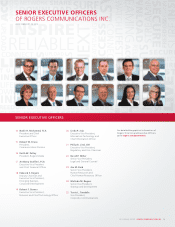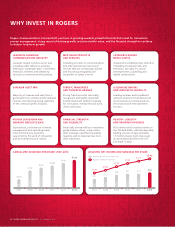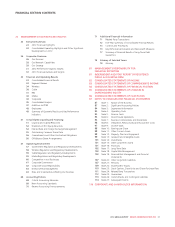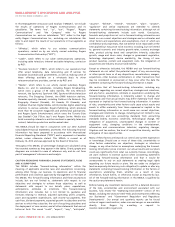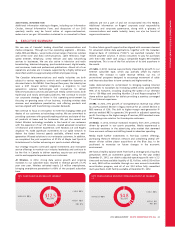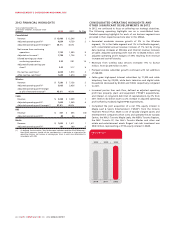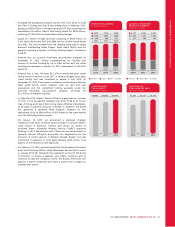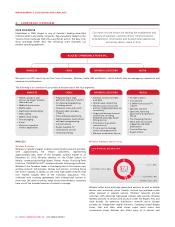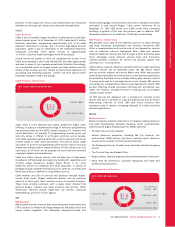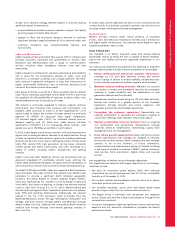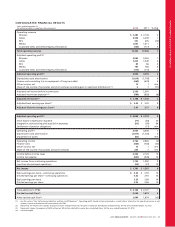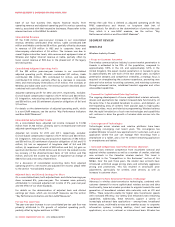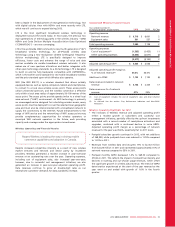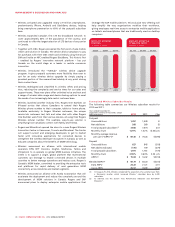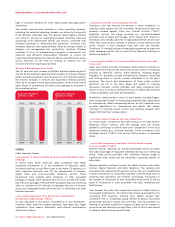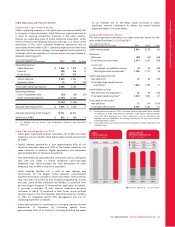Rogers 2012 Annual Report Download - page 33
Download and view the complete annual report
Please find page 33 of the 2012 Rogers annual report below. You can navigate through the pages in the report by either clicking on the pages listed below, or by using the keyword search tool below to find specific information within the annual report.
MANAGEMENT’S DISCUSSION AND ANALYSIS
As part of its network strategy, Wireless expects to continue making
significant capital investments to:
• acquire additional wireless spectrum needed to support the rapidly
growing usage of wireless data services;
• expand its fibre and microwave transport network to maintain
significant backhaul capacity between all of its network nodes; and
• introduce innovative new network-enabled features and
functionality.
Cable and RBS Networks
Cable’s expansive fibre and hybrid fibre coaxial (“HFC”) infrastructure
provides consumers, businesses and governments in Ontario, New
Brunswick and Newfoundland with a range of communications
services, including video, broadband Internet, voice and data
networking.
Cable’s network is architected to optimize performance and reliability
and to allow for the simultaneous delivery of video, voice and
Internet to a consumer’s premises over a single platform. The fibre-
optic network is generally configured in rings that interconnect its
highly concentrated distribution hubs to minimize disruptions that
can result from fibre cuts and other events.
Each group of homes is served by a fibre-connected optical network
node. This is commonly called Fibre-to-the-Feeder (“FTTF”), and it has
the capability of utilizing 860 MHz of spectrum to deliver video, voice
and broadband services to that group of homes.
The network is continually upgraded to improve capacity, enhance
performance and introduce new features and functionality. For
example, Cable continues to invest in: (i) the “segmentation” of its
optical nodes to reduce the number of homes served in a particular
segment; (ii) MPEG4 for improved video signal compression;
(iii) switched digital video (“SDV”) for increased channel and on-
demand capacity; and (iv) Data Over Cable Service Interface
Specification (“DOCSIS”) 3.0 for increasingly faster Internet, with
speeds now up to 150 Mbps across 90% of our footprint.
In 2012, Cable began transitioning customers still receiving television
signals over its analog broadcast channels to all-digital services. Doing
so frees up significant cable network capacity for enabling additional
features and services. Some recent offerings launched include whole
home PVR, remote PVR, next generation set-top boxes, enhanced
content guides and search functionality, and video streaming on a
variety of screens including tablets, smartphones and gaming
consoles.
Cable’s voice-over-cable telephony services are provisioned over an
advanced broadband IP multimedia network layer, utilizing the
Packet Cable and DOCSIS standards, including network redundancy as
well as multi-hour network and customer premises backup powering.
On behalf of Wireless and RBS, Cable also operates a North American
transcontinental fibre-optic network that extends over 38,000 route
kilometers to provide a significant North American geographic
footprint. This allows Rogers to connect Canada’s largest markets,
while also reaching key U.S. markets for the exchange of data and
voice traffic, also known as peering. In Canada, the network extends
coast to coast from Victoria, B.C., to St. John’s, Newfoundland and
includes local and regional fibre, transmission electronics and systems,
hubs, POPs and switching infrastructure. Additionally, the network
extends to the U.S., from Vancouver south to Seattle; from the
Manitoba-Minnesota border through Minneapolis, Milwaukee and
Chicago; and from Toronto through Buffalo and Montreal, through
Albany to New York City. Cable has also connected its North American
network with Europe through international gateway switches in
New York City.
In certain cases, where Cable does not have its own local facilities that
connect directly to a business customer’s premises, the local service is
provided under a third party wholesale arrangement.
Media Networks
Media’s principal network assets consist primarily of broadcast
studios, radio and television transmission facilities and a distribution
and digital media infrastructure. This network allows Rogers to reach
Canadian audiences coast to coast.
OUR STRATEGY
Our mandate is to deliver long-term value and industry-leading
shareholder returns by being the first in Canada to deliver seamless,
easy-to-use and reliable end-to-end supported experiences to our
customers.
Our actions and investments are guided by the following six long-term
strategic objectives that will help to ensure we deliver on our mandate:
1. Deliver differentiated end-to-end customer experiences:
Leverage our LTE and Cable networks, services and content
across a range of devices to enable seamless, reliable and easy-
to-use customer experiences anytime, anyplace and anywhere.
2. Maintain industry-leading networks: Maintain our position
as a leader in wireless and broadband networks by continually
investing in speed, reliability and the enablement of next
generation features and functionality.
3. Expand our services reach: Bring our LTE and Cable networks,
services and content to a greater portion of the Canadian
population through network and service expansion and
upgrades, partnerships and strategic acquisitions.
4. Strengthen the customer experience: Demonstrate our
ongoing commitment to customers by continually investing in
our product offerings, retail channels, service and support.
5. Improve productivity and cost structure: Focus on ongoing
cost optimization and productivity improvements through
initiatives aimed at simplification, streamlining, supply chain
management and cost management.
6. Drive future growth opportunities: Select and nurture future
growth opportunities that leverage our strengths in network,
services and content delivery. Work internally and with strategic
partners to be at the forefront of future information,
communications and entertainment services in Canada, including
in the areas of machine-to-machine (“M2M”), mobile commerce,
local services, home automation, digital media and business
services.
Our Capabilities to Deliver on Our Strategic Objectives
Our capabilities and resources that support execution on our strategic
objectives include:
• We have an investment grade balance sheet with relatively
conservative borrowing leverage and over $3.1 billion of available
liquidity as of December 31, 2012.
• Our modern wireless and broadband networks allow us to deploy
innovative products and services.
• Our Canadian broadcast, sports, print and digital media assets
provide unique content for our communications products.
• The Rogers brand is extremely well recognized and respected
across Canada, and we have a broad retail presence through which
we market our products.
• Our senior management team has significant industry and technical
expertise and our executive compensation programs are heavily
performance based.
2012 ANNUAL REPORT ROGERS COMMUNICATIONS INC. 29


